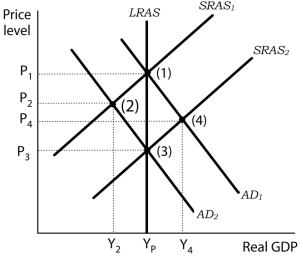Multiple Choice
Use the following to answer questions .
Exhibit: Responses to a Decrease in Aggregate Demand 
-(Exhibit: Responses to a Decrease in Aggregate Demand) The economy is initially in equilibrium at point (1) . Now suppose a reduction in the money supply causes aggregate demand to fall to AD2. Which of the following explains the new classical view regarding economic agents' response to the decrease in money supply?
A) Consumers and firms observe that the money supply has fallen and that the price level has fallen to P2. Consumers respond by increasing their demand for output and firms in turn increase their supply to meet the rising demand. The economy moves back to point (1) .
B) Consumers and firms observe that the money supply has fallen and that the price level has fallen to P2. To prevent further reductions in the price level, firms increase output at the same time as consumers increase aggregate demand. The economy moves to point (4) , bypassing point (3) .
C) Consumers and firms observe that the money supply has fallen and anticipate the eventual reduction in the price level to P3. They adjust their expectations accordingly. Workers agree to lower nominal wages, and the short-run aggregate supply curve shifts to SRAS2 at the same time as aggregate demand falls, bypassing point (2) .
D) Consumers and firms observe that the money supply has fallen and anticipate the eventual reduction in the price level to P4. They adjust their expectations accordingly. Workers agree to lower nominal wages, and the short-run aggregate supply curve shifts to SRAS2 at the same time as aggregate demand rises, moving the economy to point (4) .
Correct Answer:

Verified
Correct Answer:
Verified
Q37: While Keynes argued that the Great Depression
Q38: In the U.S., the Great Recession was
Q39: In the 1970s, the U.S. economy saw
Q40: During the 1960s, Keynesian economic policies led
Q41: During the 1970s when the U.S. experienced
Q43: The inability of the government to stabilize
Q44: Early classical macroeconomics was based largely on
Q45: Use the following to answer questions .<br>Exhibit:
Q46: In 1965 during the Johnson administration, the
Q47: Economists who subscribe to the rational expectations